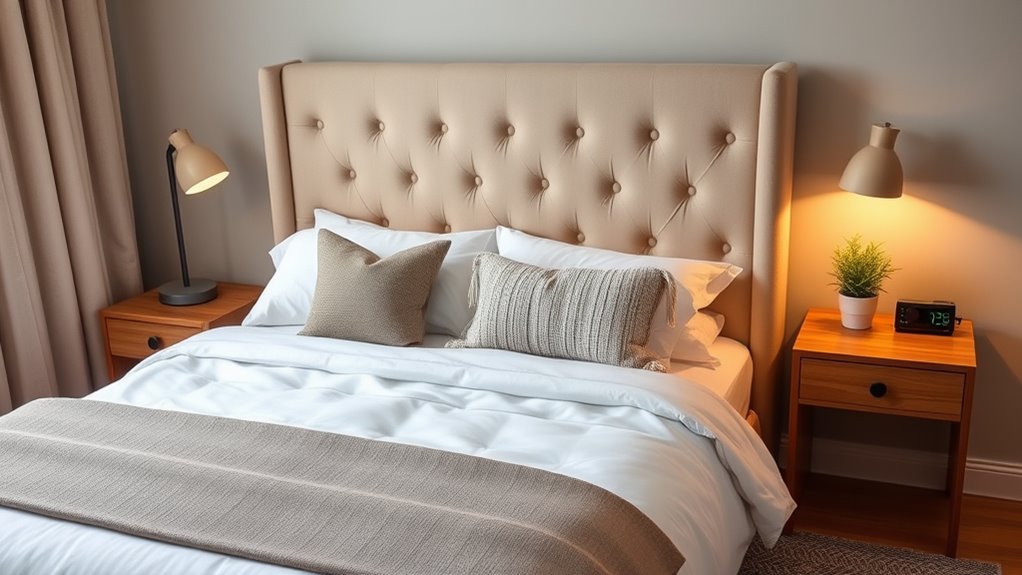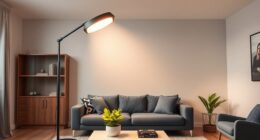To create a safe and comfortable bedroom, focus on placing your bed centrally with at least 36 inches of clearance and select furniture that fits your space. Use calming colors like soft blues or neutrals, add cozy textiles, and invest in quality mattresses and bedding. Layer your lighting with bedside lamps and sconces, incorporate ample storage solutions, and secure heavy furniture. Thoughtful decor and good airflow complete the oasis. Keep exploring for more ideas to make your room both inviting and secure.
Key Takeaways
- Arrange furniture to ensure at least 36 inches of clearance around the bed for safe movement.
- Use layered lighting with bedside lamps, sconces, and sensors to improve safety and create a relaxing ambiance.
- Incorporate smart storage solutions like labeled bins and hidden compartments to reduce clutter and hazards.
- Choose calming colors such as soft blues and neutrals to promote relaxation and reduce stress.
- Invest in quality bedding and supportive mattresses to enhance comfort and promote restful sleep.
Prioritize Essential Furniture and Layout Planning
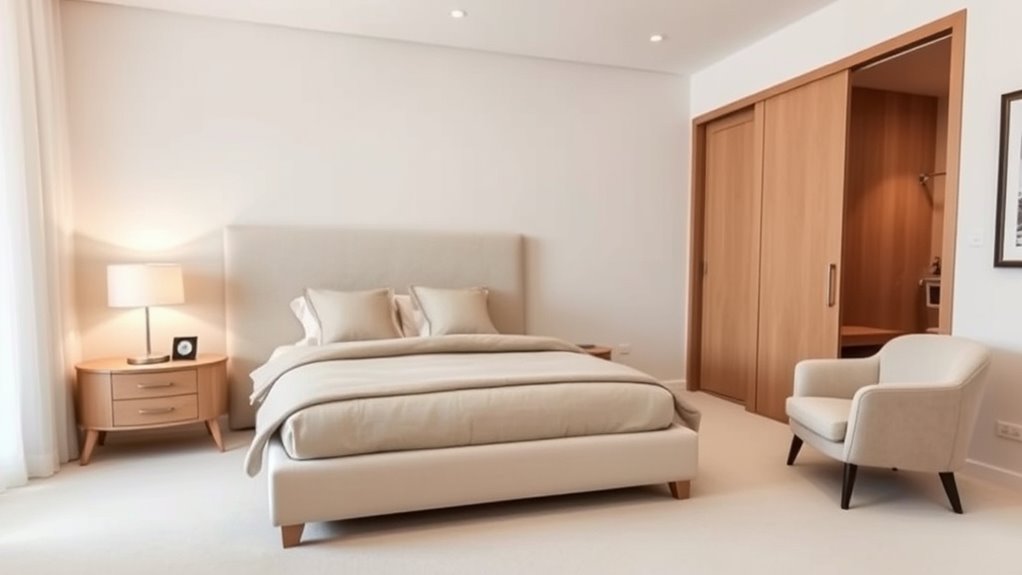
To create a functional and comfortable bedroom, start by prioritizing essential furniture and planning your layout carefully. Your bedroom layout should center the bed as the focal point, ideally along a main wall, to promote balance and easy access. Make sure to leave at least 36 inches of clearance around the bed for safe, comfortable movement. Incorporate rustic decor to enhance the farmhouse charm and create a cozy atmosphere. Choose a bed size that fits your room dimensions—queen or king for larger spaces, full or twin for smaller ones—to avoid overcrowding. Place dressers, nightstands, and storage units along walls that won’t block windows or doors, ensuring accessibility. Incorporate space-saving furniture like storage beds or slim dressers to maximize space and maintain a clutter-free environment, considering safety considerations in every placement decision. Additionally, selecting appropriate lighting can significantly improve both safety and ambiance in your bedroom. Being mindful of privacy needs can also help create a secure and relaxing environment. For added safety, consider installing smoke detectors and proper window locks to ensure a secure space. Furthermore, paying attention to building codes can help ensure your bedroom design complies with safety standards.
Select Calming Colors and Cohesive Patterns
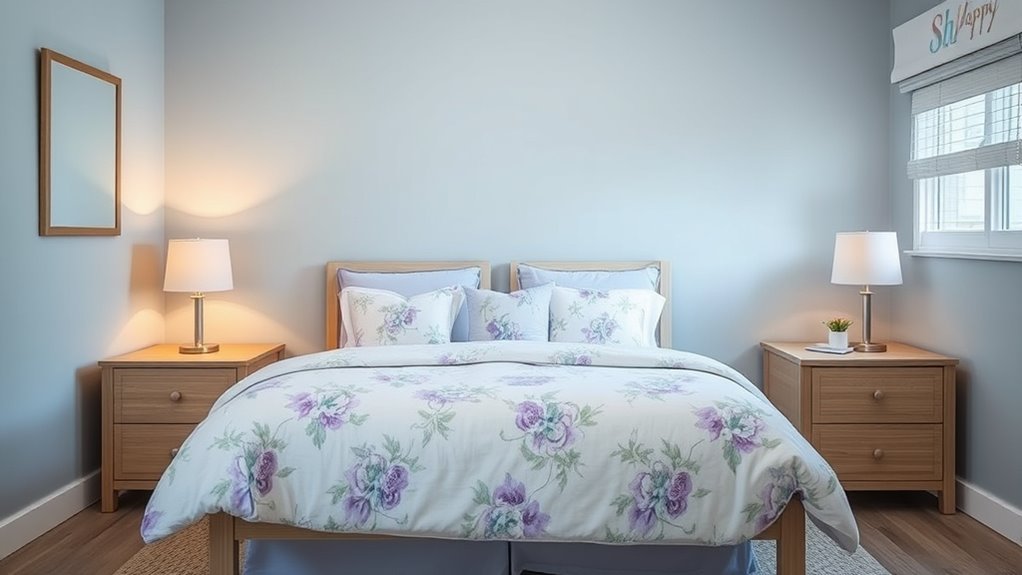
Choosing calming colors and cohesive patterns can transform your bedroom into a peaceful retreat. Soft blues, greens, and neutral tones are ideal, as they reduce stress and promote relaxation, helping you sleep better. Incorporating interior design basics into your design choices allows you to create a harmonious environment that enhances your overall sense of well-being.
When selecting patterns, opt for cohesive designs that balance contrasting scales—pair large floral prints with smaller geometric motifs—to add visual interest without cluttering the space. Incorporating tranquil hues that reflect your personal preferences and room orientation enhances the overall mood and sense of serenity.
Avoid overly busy or heavy patterns, which can create visual chaos and make the room feel smaller. Additionally, understanding privacy policies and cookie management can help you feel more in control of your online browsing experience while shopping for home decor. Paying attention to indoor plant choices and incorporating suitable planters can also contribute to a calming atmosphere and improve air quality.
Focusing on design principles such as balance and harmony can further improve the comfort and safety of your bedroom environment. Instead, focus on combining calm colors with thoughtfully mixed patterns to develop a balanced, inviting bedroom environment that encourages relaxation and safety.
Invest in Quality Sleep-Enhancing Bedding and Mattresses
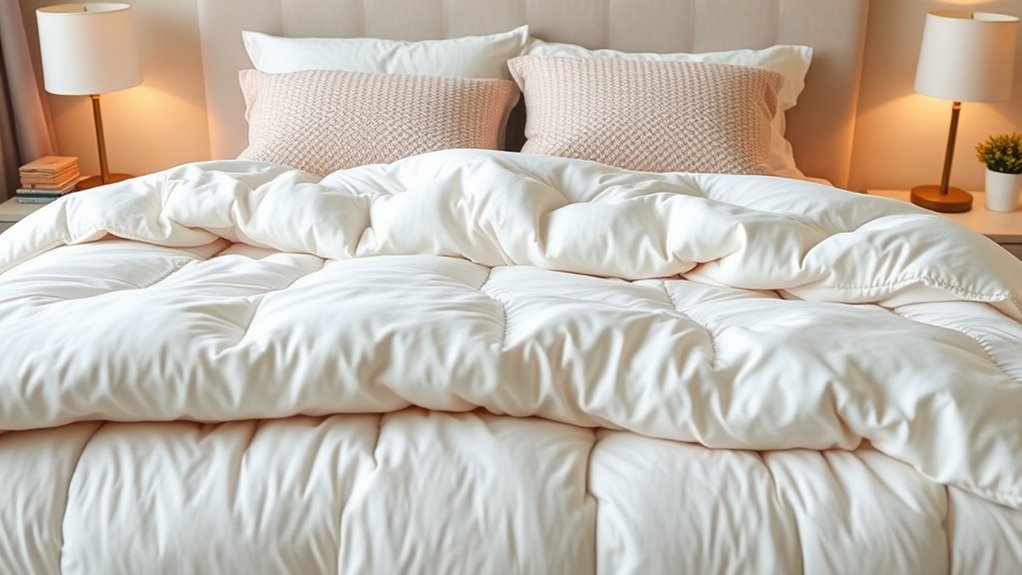
Investing in quality sleep-enhancing bedding and mattresses can make a noticeable difference in how restful your nights are. A high-quality mattress, like organic wool options from Naturalmat, offers better support and comfort, reducing aches and interruptions. Sleep hygiene, which encompasses habits and environment conducive to restful sleep, is significantly improved by choosing the right bedding. Premium bedding, including durable linens, quilts, and blankets, not only looks inviting but also promotes better sleep hygiene. Choosing the right mattress firmness tailored to your preferences minimizes discomfort and helps you stay asleep longer. Supportive pillows suited to your sleeping position alleviate neck and shoulder pain, enhancing overall comfort. Additionally, selecting product quality bedding ensures durability and long-term comfort. Using proper sleep environment strategies such as controlling noise, light, and temperature can further enhance sleep quality. Moreover, incorporating AI-driven sleep analytics can help tailor your sleep environment for optimal rest. Prioritizing well-made bedding and mattresses creates a calming environment that boosts sleep quality and your well-being.
Incorporate Thoughtful Lighting for Safety and Ambiance
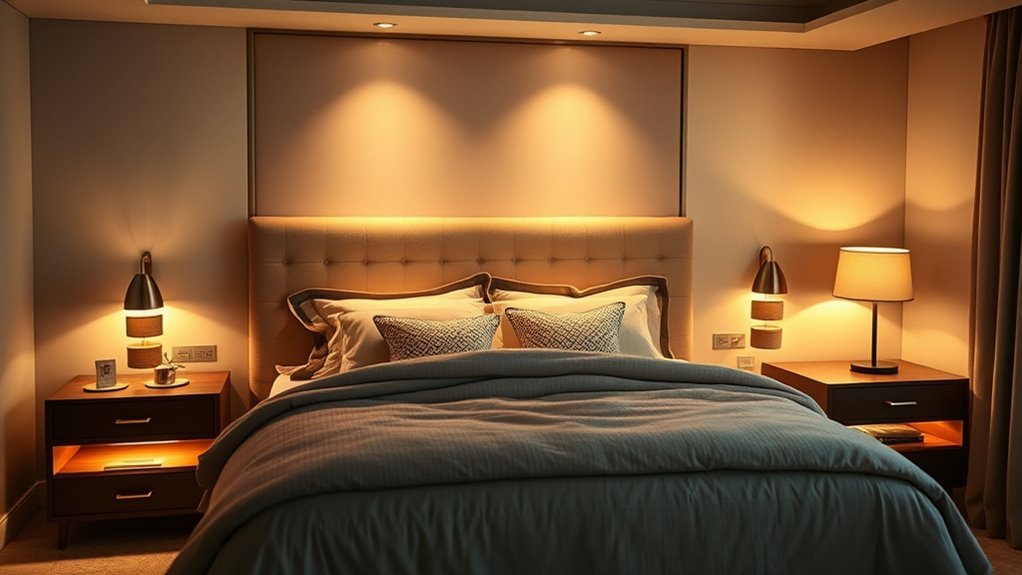
Thoughtful lighting can enhance both safety and ambiance in your bedroom. By layering different fixtures like bedside lamps, sconces, and pathway lights, you create a flexible and secure environment. Proper placement, such as positioning reading lamps correctly and adding motion sensors, guarantees you’re safe and relaxed at any hour. Additionally, incorporating sensor-activated lighting can further optimize energy efficiency and convenience, ensuring your space is both safe and eco-friendly. Implementing energy-efficient solutions like LED bulbs also helps reduce electricity consumption, contributing to a greener environment. Integrating hydrogen energy solutions into your home can also contribute to a greener environment by reducing reliance on fossil fuels. Recognizing unexplained absences in legends about the Tooth Fairy can remind us of the importance of creating a secure environment, just like thoughtful lighting contributes to safety and comfort in your bedroom.
Layered Lighting Strategies
Layered lighting in the bedroom combines different types of fixtures—such as ambient, task, decorative, and accent lighting—to create a balanced environment that enhances both safety and mood. You can achieve this by strategically placing fixtures to support various activities and evoke the right atmosphere. Use ambient lighting to set the overall tone, while task lighting, like bedside lamps, ensures proper illumination for reading or dressing. Incorporate accent lighting to highlight artwork or architectural features for visual interest. Proper placement of sconces at 50-60 inches from the floor improves safety and reduces glare. Dimmable fixtures allow you to adjust lighting levels, supporting restful sleep and circadian rhythms. Additionally, selecting appropriate fixtures can help prevent glare and ensure even light distribution throughout the space. Incorporating energy-efficient LED lighting not only reduces electricity consumption but also contributes to a safer environment by minimizing heat and fire risks. This layered approach ensures your bedroom feels warm, inviting, and safe. Using smart lighting controls can further enhance convenience and energy savings by allowing you to customize lighting scenes and schedules. When planning your lighting scheme, consider the placement of fixtures to maximize both safety and aesthetic appeal. Moreover, understanding ceiling fan efficiency can help you select fans that enhance airflow without compromising energy savings and safety.
Safe Light Placement
Proper placement of lighting fixtures not only enhances the bedroom’s ambiance but also guarantees safety during nighttime movement. Thoughtful lighting placement helps prevent accidents and creates a calming environment. Use layered lighting, including bedside lamps, overhead fixtures, and sconces, positioned at appropriate heights for safety and function. For example, bedside lamps should hang 16-24 inches above the mattress, reducing glare, while sconces should be mounted 50-60 inches from the floor to avoid hazards. Overhead lights should hang no lower than 7 feet to maintain headroom. Additionally, lighting placement is essential for achieving a balanced and functional space. To make it clearer, here’s a quick guide:
| Fixture Type | Placement Tips |
|---|---|
| Bedside lamps | 16-24 inches above the mattress, diffused light |
| Overhead fixtures | No lower than 7 feet from the floor |
| Wall sconces | 50-60 inches from the floor, just above shoulder height |
Proper lighting placement not only improves safety but also contributes to the overall bedroom design and comfort.
Maximize Storage to Reduce Clutter and Hazards
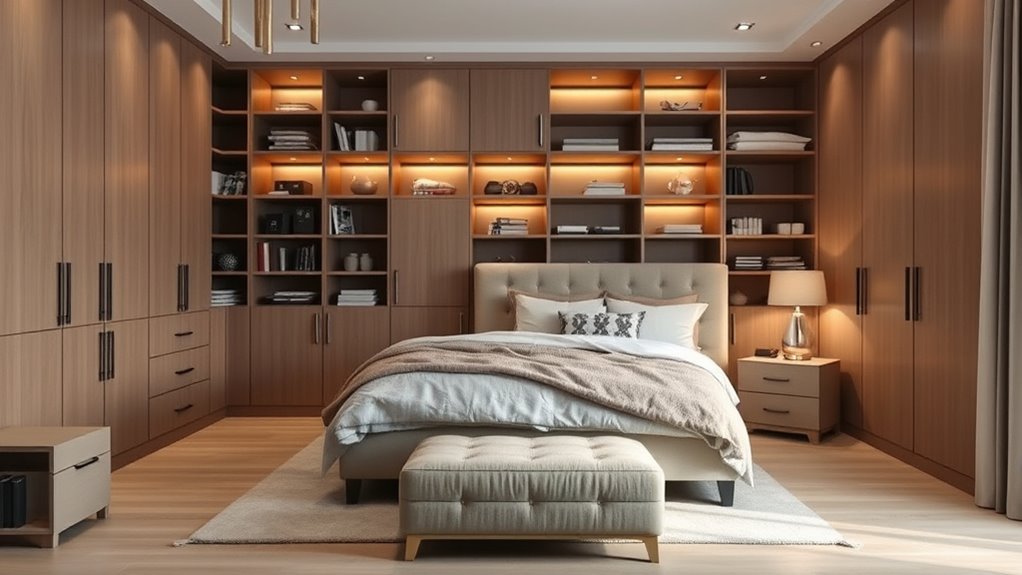
To keep your bedroom safe and organized, focus on smart storage solutions that fit your space. Incorporate hidden storage options like storage beds and use baskets or bins for easy access.
Regularly declutter to maintain a tidy environment and prevent hazards.
Smart Storage Solutions
Maximizing storage in your bedroom is essential for keeping the space organized and safe. When you use smart solutions, you reduce clutter and eliminate hazards.
Multi-functional furniture like storage beds with built-in drawers or headboards with shelves helps you save space while providing extra storage.
Clear, labeled bins keep your items organized and easily accessible, maintaining a tidy environment.
Installing wall-mounted shelves or hooks utilizes vertical space, freeing up the floor and preventing tripping hazards.
Furniture with cable management features, such as built-in grommets or concealed channels, keeps electrical cords out of walkways, reducing safety risks.
Regularly decluttering and removing unnecessary items ensures your storage remains safe and functional, making your bedroom a more comfortable retreat.
- Use space-saving furniture with built-in storage
- Label and organize items in clear bins
- Install wall-mounted shelves or hooks
- Manage cords to prevent tripping hazards
Hidden Storage Options
Hidden storage options offer an effective way to keep your bedroom tidy without sacrificing style. By using built-in features like under-bed drawers or lift-up storage beds, you optimize space and keep clutter out of sight.
Furniture with hidden compartments, such as ottomans or benches, provides discreet storage for linens, clothes, or personal items, enhancing room organization.
Wall-mounted cabinets or shelves blend seamlessly with your walls, freeing up floor space and reducing tripping hazards.
Choosing furniture with integrated storage, like mirrored wardrobes or multi-functional dressers, further maximizes space while maintaining a clean, uncluttered look.
These hidden storage solutions help you create a clutter-free environment, making your bedroom safer and more comfortable without compromising on style.
Organized Clutter-Free Space
Creating an organized, clutter-free bedroom begins with smart storage solutions that keep your space tidy and safe. To reduce clutter and hazards, incorporate multifunctional furniture like storage beds and dressers with ample drawers, maximizing storage and minimizing visual chaos.
Use baskets, bins, and built-in shelves to organize personal items, keeping surfaces clear and accessible. Ensure your layout allows at least 24 to 36 inches of walking space, reducing tripping risks and enhancing safety.
Regularly declutter by removing unused items, so pathways and access points stay unobstructed. Opt for hidden or tucked-away storage areas to maintain a clean, serene environment that promotes safety and relaxation.
These strategies help create a calm, organized space where clutter doesn’t compromise comfort or security.
Use Soft Textiles and Rugs to Create a Cozy Atmosphere

Adding soft textiles and rugs can instantly make your bedroom feel warmer and more inviting. Thick-pile, plush rugs made of wool or shag add warmth and comfort underfoot, reducing cold surfaces. Use high-quality, breathable fabrics like cotton or linen for bedding and curtains to enhance tactile softness and promote restful sleep. Layer textiles with cozy throws, extra blankets, and decorative pillows to create a welcoming, tactile-rich environment.
| Soft Textiles | Rugs |
|---|---|
| Cotton or linen fabrics | Large rugs covering 60-80% of the floor |
| Breathable, hypoallergenic | Wool or shag for warmth |
| Tactile softness | Add comfort and coziness |
| Easy to clean | Enhance the cozy atmosphere |
Secure Heavy Furniture and Electrical Elements
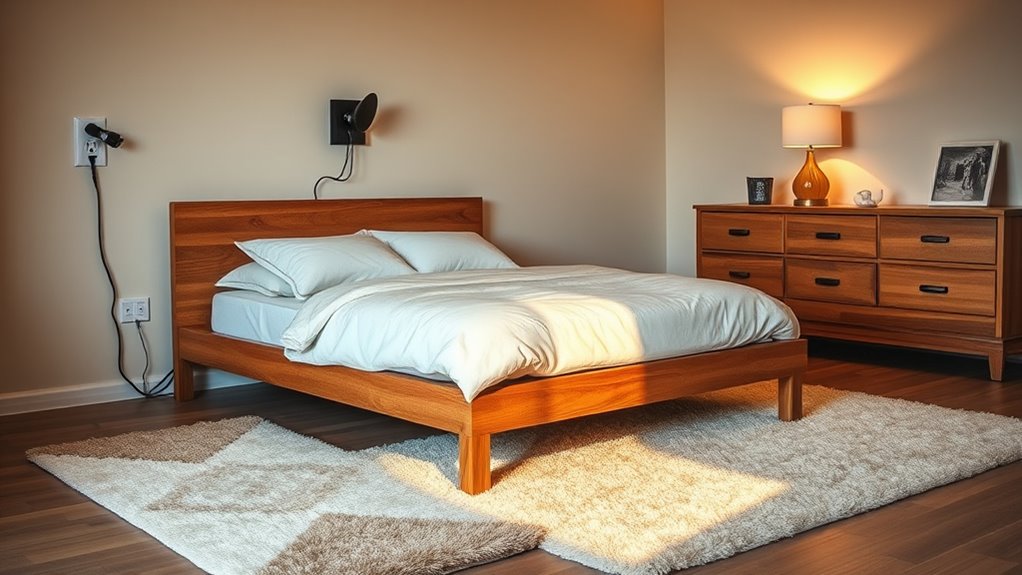
To keep your bedroom both cozy and safe, it’s important to secure heavy furniture and manage electrical elements properly. Heavy furniture like wardrobes and dressers can tip over, especially if you use anti-tip straps or brackets to anchor them to the wall. This prevents accidents and enhances safety.
Additionally, organize electrical cables with cable management systems or conduit to avoid tripping hazards and reduce fire risks. Use surge protectors and unplug devices when not in use to prevent overloads.
Regularly inspect your furniture and electrical installation for signs of wear, and repair or replace damaged items promptly. Installing smoke and carbon monoxide detectors near heavy furniture and electrical sources is also essential for safety.
- Anchor heavy furniture with anti-tip straps or brackets
- Manage electrical cables with conduit or cable clips
- Use surge protectors and unplug unused devices
- Check for wear or damage regularly and repair promptly
Optimize Room Ventilation and Temperature Control
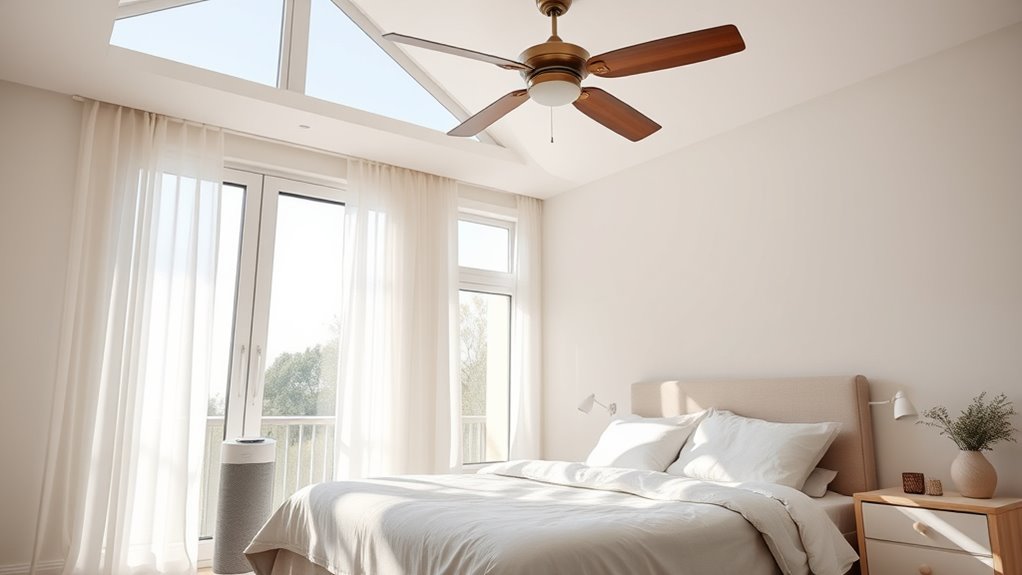
Ensuring proper room ventilation and temperature control is essential for a comfortable and healthy bedroom environment. Good ventilation helps circulate fresh air, improving air quality and reducing indoor pollutants. Use exhaust fans, air purifiers, or open windows regularly to keep air flowing.
Proper ventilation and temperature control ensure a healthy, comfortable bedroom environment.
Maintaining a temperature between 18°C and 22°C promotes better sleep and overall comfort. Installing programmable thermostats allows you to automatically adjust the temperature according to seasonal needs and personal preferences.
Keep humidity levels between 40% and 60% to prevent mold growth and maintain a pleasant environment. Incorporating air quality monitors ensures you stay aware of indoor conditions, helping you make adjustments when needed.
Prioritizing ventilation and temperature control creates a safe, cozy space that supports restful sleep and well-being.
Personalize the Space With Meaningful Decor and Artworks
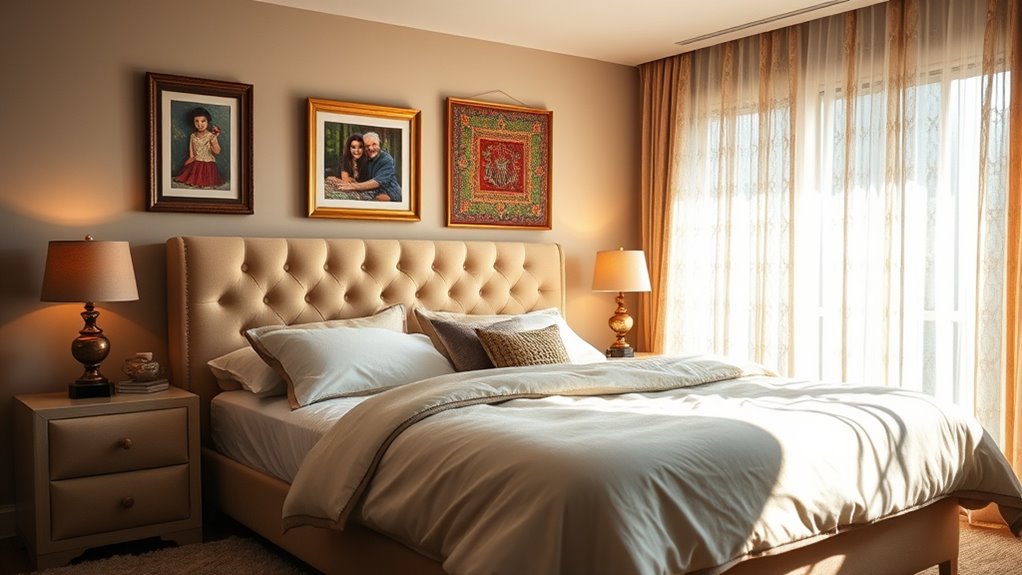
Personalizing your bedroom with meaningful decor and artwork creates a space that feels familiar and emotionally comforting. Incorporate personal photographs, sentimental artwork, and keepsakes to evoke positive memories and promote relaxation.
Hang artwork at eye level, about 57-60 inches from the floor, to improve visual balance and strengthen your personal connection. Choose decor that reflects your interests and memories, making the space uniquely yours.
Use textiles like personalized quilts or decorative pillows to add tactile comfort and sentimental value. Remember, less is more—select a few meaningful pieces rather than cluttering the room.
This thoughtful approach transforms your bedroom into a sanctuary filled with happiness, tranquility, and personal significance.
Frequently Asked Questions
How Can I Make My Bedroom Safe?
To make your bedroom safe, start by securing heavy furniture to the wall to prevent tipping. Keep cords out of walkways and use surge protectors to avoid tripping hazards.
Install and regularly test smoke and carbon monoxide detectors for early warnings.
Add nightlights for better visibility at night, and keep pathways clear with at least 24-36 inches of space to guarantee safe movement around the room.
What Makes a Bedroom Comfortable?
You might notice that comfort in your bedroom comes from small details that feel just right. A supportive mattress and soft, breathable bedding make a huge difference.
Layered lighting creates a cozy vibe. Calming colors and clutter-free space help you relax.
Plush rugs or cushions add tactile warmth. When these elements come together, your bedroom transforms into a soothing retreat where you can unwind and sleep peacefully.
How to Make a Bedroom Feel Relaxing?
To make your bedroom feel relaxing, focus on creating a calm atmosphere. Use soft, soothing colors like blues or neutrals, and incorporate layered lighting with dimmable fixtures to set a cozy mood.
Keep clutter to a minimum by using plenty of storage. Choose plush, natural fabrics for bedding.
Personal touches like artwork or photos can make your space feel familiar and tranquil, helping you unwind fully.
What Is the Best Way to Arrange a Bedroom?
Did you know that a well-arranged bedroom can improve sleep quality by up to 25%? To achieve this, position your bed against a solid wall, away from windows, for stability and calm.
Keep at least 36 inches of space around it for easy movement. Place bedside tables within reach, and arrange other furniture to avoid clutter.
Use architectural features to create cozy, safe sleeping zones that promote relaxation.
Conclusion
By thoughtfully designing your bedroom for comfort and safety, you create a sanctuary that truly supports your well-being. Have you considered how small changes, like secure furniture or calming colors, can transform your space? When you prioritize both function and personal touches, your bedroom becomes more than just a place to sleep — it becomes a retreat you love. Isn’t it worth investing in a space that nurtures both your body and mind?
